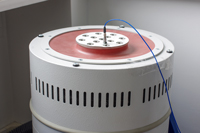 Pressure transducers can be used in off-road equipment, construction machinery, performance racing, railroads, engines, and other applications where a transducer may be exposed to shock and vibrations. Transducers can be exposed to shock and vibrations through normal use, as well as during maintenance. Although not all applications subject a transducer to shock or vibrations, these devices tend to be very sensitive and their ability to accurately read pressure can be affected easily.
Pressure transducers can be used in off-road equipment, construction machinery, performance racing, railroads, engines, and other applications where a transducer may be exposed to shock and vibrations. Transducers can be exposed to shock and vibrations through normal use, as well as during maintenance. Although not all applications subject a transducer to shock or vibrations, these devices tend to be very sensitive and their ability to accurately read pressure can be affected easily.
 There are two primary types of vibration testing: sinusoidal and random. Sinusoidal vibration testing applies a single frequency using rotating or oscillating machinery, while random vibration testing applies vibration at all frequencies within a specific range. Because of this unpredictability, random vibration testing tends to more closely resemble an actual application. There are several types of shock tests depending on the intended application for a transducer. For example, commercial products can undergo a shock or be subject to a free fall test.
There are two primary types of vibration testing: sinusoidal and random. Sinusoidal vibration testing applies a single frequency using rotating or oscillating machinery, while random vibration testing applies vibration at all frequencies within a specific range. Because of this unpredictability, random vibration testing tends to more closely resemble an actual application. There are several types of shock tests depending on the intended application for a transducer. For example, commercial products can undergo a shock or be subject to a free fall test.
Shock and vibration on an existing transducer can be minimized by fitting the transducer with suspensions. When specifying a new transducer, it is vital to consider the design, material and construction of the device. A ceramic sensor, for example, cannot withstand shock and vibrations as well as an oil-filled sensor. Process connections and steel housings can provide additional protection.
 Several regulatory agencies provide guidelines for product testing against shock and vibration. The International Electrotechnical Commission (IEC) is one regulatory body that sets the standards for transducers. The IEC 60068 Standards describe random, sinusoidal vibration, shock, and free fall testing parameters to assess for occurrences in most applications. A product’s test parameters and adhered regulatory agency standards are typically on the product’s data sheet.
Several regulatory agencies provide guidelines for product testing against shock and vibration. The International Electrotechnical Commission (IEC) is one regulatory body that sets the standards for transducers. The IEC 60068 Standards describe random, sinusoidal vibration, shock, and free fall testing parameters to assess for occurrences in most applications. A product’s test parameters and adhered regulatory agency standards are typically on the product’s data sheet.
As with testing parameters, it is important to check the product’s data sheet to ensure transducers are appropriately rated for an intended application. By understanding the application and potential for shock and vibration damage, selecting the correct transducer will be a straightforward decision.

